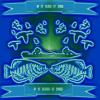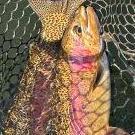Catching Shad has given more than one angler fits, Most people look for the schools on the surface of the water which can be productive at times, but by far the best method is getting them in backs of coves, over mud flats or best of all in small creek mouths where they have little running room to escape a cast net.
Open Water netting posses a major issue, Shad are fast and moving, I have seen many guys throw at the school with their net and then look puzzled when they come up with just a couple shad. Remember refraction which is to say you see a target under water at what looks like 2 feet when in reality it is 3 feet. Also they are moving. When you see schools follow them for a few seconds and see where they are going. Cast your net in front of the school at least 3 feet and a 2 feet beyond them. This normally will put you center of the school and a full net.
Backs of coves and mud flats are great areas to get them. You still have to use the same principles for casting a net as you do in open water but you have higher odds of catching them in these areas. Be careful though of underwater dangers to a net. Know your depth and only let the net sink to half the bottom depth will help keep nets out of danger.
Creeks and especially creek mouths. Just the simple fact most are narrow make catching shad very easy in these area. I seldom pay attention to sigh casting them in these area. I use the sight to know where they are but beyond that it’s irrelevant! Cast beyond where you see the shad and let the net sink. Normally you will be where the true school is and will be pulling in a heavy load of shad for fishing.
Keeping Shad alive is NOT easy!!! Shad do not do well in unclean water, low oxygenated water or takes that are square. The water in your bait tank may look clear but shad are like pigeons the poop everyplace and a lot as well as release a lot of ammonia from their urine. For the inventive angler a trash can be cut in half and used with bilge pump to fill it and a relief hole to allow water out. Or buy a circular or oval style bait tank. Some boats like mine have bait tanks that are oval or rounded corners. These will work fine for keeping shad from beating themselves up, but not from the water quality issues if the angler does not pay attention to it.
Many anglers do not understand how fragile this bait is. If you have a bait tank onboard that is suitable for shad you will want to have the drain running drain plug out and fill on constantly or at very least on timer. Do NOT forget to clean the screen on the filter frequently. You will want to do this for the first hour after catching the shad. After that keep your aerator on timer and once an hour repeat the full procedure.
Hooking Shad, There are three good ways to hook shad! First is nose hooking, take the hook and run it through the upper jaw through the nose {be sure not to hook the bottom jaw} you want them to breath and swim naturally. This type of hooking allows the shad to do what it wants and swim naturally.
Next is Anus hooking them, You hook them just like it says directly above the butthole. This method will cause the shad to swim down and near the bottom. The problem is it puts a lot of stress on the shad and they are only good for about 5 minutes at most, so be ready to change them frequently. It is not a good option if you are limited in bait in the tank.
Lastly is tail hooking them! You actually do not hook them in the tail but between the dorsal fin and the tail. A good rule of thumb is hooking them where the threadfin stops and just below the back bone. This will cause them to run away from the boat, you will need to play out line to allow them to keep running. When the shad stops running keep your reel in free spool and let the shad swim. I have had them live fine for 15 minutes no problem but as soon as you start reeling them in you stress them bad, So if you reel them in change them out.
Hook size’s are where I see more anglers make mistakes then anyplace else. The smallest possible hook size the better, For shad under 3’’ the best hook size is a #4 and for shad from 3’’ to 6’’ a 1/0 hook is perfect for nose hooking and a 3/0 for Tail or Anus hooking. These give the shad the best movement and least amount of stress and are perfectly capable of handling a big fish. I have personally caught Tarpon over 150pnds on a 3/0 hook.
Line is another factor. If you want natural looking bait then use the lightest line possible, I prefer Fluorocarbon line myself, 12lbs is perfect for most freshwater fish for fly lining (hook only to line no weight) and 20lbs Fluorocarbon for Bait that has a weight above it.
In summer I suggest adding ice to the bait tank to keep the temperature down. This has a negative aspect to it as most bagged ice or made at home has additives in it that can harm shad, to counter this deadly problem simply purchase SHAD KEEPER at your local bait or sporting goods store, it removes these harmful additives and also controls ammonia from the shad.
Finally do not discard dead shad! Put them in a bucket and if the fish start surface feeding toss out the dead bait to them and keep them feeding ( know your local laws on chumming before doing this though) This can also be deadly productive on getting deep fish to turn on and come up.




Recommended Comments
There are no comments to display.
Create an account or sign in to comment
You need to be a member in order to leave a comment
Create an account
Sign up for a new account in our community. It's easy!
Register a new accountSign in
Already have an account? Sign in here.
Sign In Now